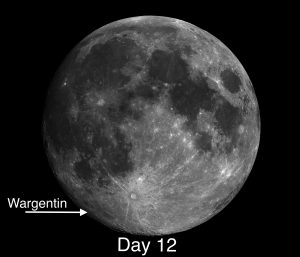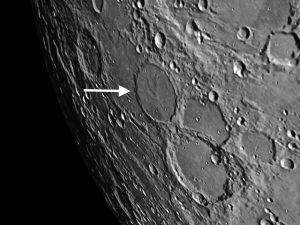The week of August 15th-21st takes us from Day 12 through Day 18. Full moon is on Thursday the 18th, so to see crater contrast you must look very near the terminator a few days before and after full moon. This week we will feature the crater Wargentin.
• Wargentin: On Monday night, check out the crater Wargentin (Field Map of the Moon grid SW/P4). This is one of the more unusual craters on the Moon. When you catch Wargentin in the right light, it has a fascinating story to tell. There is an almost inviolable rule that crater floors must be lower than their surrounding terrain. Not so with Wargentin! Unlike most crater impacts that leave obvious depressions, the projectile that created Wargentin blasted out a large hole, then opened up cracks and fissures that pierced through to the molten zone far below. Subsequently, hot lava rose through these openings, filled Wargentin’s empty bowl to the brim, then inexplicably stopped just before spilling over!
If the Sun is at a low enough angle, the wrinkle ridge pattern on the surface of Wargentin looks as if an enormous chicken stamped its foot on the ground and flew off just as the lava congealed, leaving its imprint to tantalize the imagination of future astronomers.
OF ADDITIONAL INTEREST IN SPACE FROM AUGUST 15-21st:
Mercury, Venus, and Jupiter are very low over the western horizon at the end of civil twilight around 8:30 PM in your time zone. As soon as the brighter stars appear, scan the western horizon below Jupiter and you will see something that the great Copernicus himself never saw, the planet Mercury. Next week, on Aug. 27th, Venus and Jupiter will be practically on top of each other with only 0.1° separating them.
======================
It is highly recommended that you get a copy of Sky and Telescope’s Field Map of the Moon, the very finest Moon map available for use at the telescope. It is available for $10.95 at www.skyandtelescope.com and on Amazon. All features mentioned in this blog will be keyed to the grid on the Field Map and will look like this: Plato: [NW/D9]
Credits:
Courtesy of Gray Photography of Corpus Christi, Texas
Lunar photos: NASA / USGS / BMDO / LROC / ASU / DLR / LOLA / Moon Globe. Used by permission
- Rupes Cauchy: A Best Known Fault on the Moon - July 22, 2024
- Moon Crater Schickard – Crater Floor has Stripes - July 15, 2024
- Moon Craters Langrenus and Vandelinus - July 8, 2024

